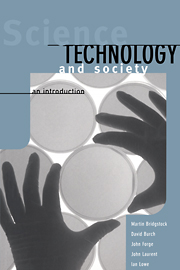Book contents
- Frontmatter
- Contents
- List of Figures
- List of Tables
- List of Contributors
- Preface
- Part One Scientific and Technological Communities
- Part Two Scientists and Technologists in the Wider Society
- 6 The Industrial Revolution in Great Britain
- 7 Science, Technology and the Economy
- 8 Science, Technology and Economic Theory
- 9 Science, Technology and Public Policy
- 10 Science, Technology and the Less-developed Countries
- 11 Science, Technology and the Future
- Appendix 1 Surviving in the Information Jungle
- Appendix 2 Referencing
- Index
10 - Science, Technology and the Less-developed Countries
Published online by Cambridge University Press: 04 February 2010
- Frontmatter
- Contents
- List of Figures
- List of Tables
- List of Contributors
- Preface
- Part One Scientific and Technological Communities
- Part Two Scientists and Technologists in the Wider Society
- 6 The Industrial Revolution in Great Britain
- 7 Science, Technology and the Economy
- 8 Science, Technology and Economic Theory
- 9 Science, Technology and Public Policy
- 10 Science, Technology and the Less-developed Countries
- 11 Science, Technology and the Future
- Appendix 1 Surviving in the Information Jungle
- Appendix 2 Referencing
- Index
Summary
Much of the content of any textbook on science, technology and society inevitably concerns the richer countries of the world, where most of the technological change associated with industrialisation has occurred, and where most of the world's research and development are carried out. But the world's wealthier countries contain only about one-third of the population of the globe. The remaining two-thirds live in the poorer countries, sometimes referred to as the Third World.
Despite their low levels of industrialisation, these poorer countries still have a major interest in science and technology, especially in terms of the contribution that they can make to solving some of the problems of poverty, malnutrition and low levels of output of goods and services. Equally, though, the nature of the relationships between science, technology and society are very different from those which occur in the rich industrialised countries. In the Third World, for example, some 70–80 per cent of the people usually still live in the rural areas and are involved in agricultural production as a way of life. This compares with a figure of 5 per cent or less for most of the industrialised countries. Differences such as these dramatically illustrate the need to think carefully about the role of Western science and technology in the lessdeveloped countries. Before going on to consider this in more detail though, it is important to discuss a little further what is meant by the Third World.
- Type
- Chapter
- Information
- Science, Technology and SocietyAn Introduction, pp. 206 - 231Publisher: Cambridge University PressPrint publication year: 1998



